Why you can trust TechRadar
The new HTC Sense UI is completely changed, thanks to being much more Google-focused. It's still Sense 7, but with a _g appended to the end in the settings to show that this is has had Google's fingers in it.
Everything that could look more like stock Android 6.0 has had the brush applied to it, meaning the notification shade is now almost identical to that offered by the new Nexus phones, the icons look more similar and the general operation will feel very familiar to anyone with the latest Android phone from Google.
Google On Tap is supported through the home button (on the screen), and is a neat addition, accessed through holding the virtual home button. It's not speedy, and does come up with some odd options, but it's clearly going to get faster and more intelligent as time goes on.

(In case you've forgotten, this will look for information on the screen and give you automatic search terms to enhance the information, as you can see on the left here).
The key thing here is that a lot of the apps that HTC fans have come to know and, well, not love but recognise, have been eradicated in favor of Google's own: Play Music, Mail and Chrome are all in.
This might not bother the thousands upon thousands that auto-download these anyway, but it does take another level of control - and thus ability to differentiate - away from HTC. By removing its own stamp on a device the speed and design take center stage and, well, we've been there in the previous section.
That's not to say it isn't an attractive interface. The notifications shade, for example, is cleaner and easier to use (although annoyingly can't be customised). The layout of the icons is the same, and the menu still has a sheen of HTC on top, looking very similar to the 'normal' Sense 7.
I'm still not a fan of the way the buttons pop in and out virtually on recent versions of Android - having them as physical keys left and right of the home button still just feels nicer, and there are times when they don't appear when you want to, even with the swipe of the screen you need.
I definitely want to give a shout out here to HTC's Themes: they're really cool and help slow down the amount of time until you download a new launcher… if at all with the new One A9, as you can customise it to such a degree that it gives it a whole new feel.
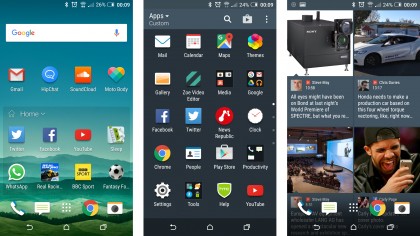
I'm starting to completely lose interest in Blinkfeed. It was something that could have been so awesome from HTC, but each time I pick up a phone to review from the brand I find myself loathing having to go through and update my news preferences time and again.
It should a) remember it from my HTC login and b) have become so fluid and relevant in the three years of development that it will always be surfacing content that I want to see.
Instead it's mostly Google+ updates, random Facebook posts and - for some reason - lunch and dinner ideas very, very sporadically.
The best so far was suggesting lunch at the Breakfast Club. Not entirely sure that's the right idea there…
Lower power engine
The HTC One A9 uses the Snapdragon 617 chipset and throws in 3GB of RAM. Well, 2GB of RAM. Wait, no, 3GB… the reason for the confusion is that it depends where you live. Europe is getting 2GB (and 16GB of internal storage) and US 3GB (with 32GB).
Asia, the lucky devil, gets both variants. Fun.
The difference could be marked, but I'm testing the 3GB variant and it's pretty nippy when it comes to most tasks. It's about as powerful as the new Nexus 5X in our Geekbench 3 test, which runs the Snapdragon 808 chipset, and for the most part it's slick under the finger.
It's not perfect though. Gaming is a notable issue, with the framerate rather lagging, despite HTC claiming that the 617's GPU should be powerful enough to handle most titles.
There are also some apps that don't like to open speedily: the camera is the biggest culprit, and that has to be down to the engine running it.
I hate to bring it up as it sounds like I'm making the same comparison for the sake of it, but there's something similar to the iPhone here.
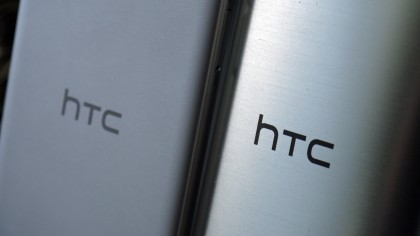
A lower power processor combined with a smaller battery, and the only way to optimise it is to be vertically integrated with the software - which HTC is doing as hard as it can.
I'd argue it could have gone quad core here - I can't see where the heavy lifting is happening, and even when trying to tidy up RAW files it's so slow that it might as well take a few seconds longer.
The battery might be saved too - although the way the chipset is split into four 'hard' cores and four 'soft' cores to work different tasks might actually make that moot.
Music
There's a decent amount of storage on this phone if you're a US or Asian dweller, and you can supplement that with a microSD card to increase things obviously.
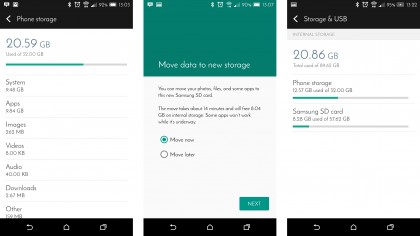
Here's the better news though: you can upgrade that internal storage by formatting the microSD card to be absorbed as internal storage - that means you can put apps, games, music and movies on there and if you've got a decent card it'll function almost as well as the internal storage thanks to the new 'Flex' mode in Marshmallow.
That means you can easily the world of music on there and still have reams of space - but Google doesn't want you to do that. It wants you to use Play Music, sync all your files to the cloud and then pay $9.99 / £9.99 / AU$11.99 to get the world of streaming content too.
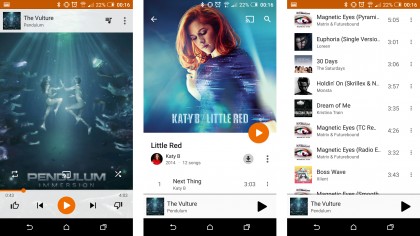
Don't worry, you can still play your own music on there, and the sound is much upgraded thanks to HTC's algorithms, Boomsound enhancement and a dedicated DAC to boost the sound and quality of the tunes.
Google Play Music isn't the most intuitive of interfaces, but it can play the upscaled music well and once you've had a nose around to see what's what, it's not hard to work out how to get the best out of your tunes.
Movies
The video playback capability of the HTC range still irks me over a half a decade on. Put a video player on there HTC. Put a brilliant one on there.
Make one that's like all the smart TVs out there, which sucks up all the video playing apps on your phone and lets you choose to go through them in one place. Let me see all my side-loaded videos on there so I can play them in the order I want.
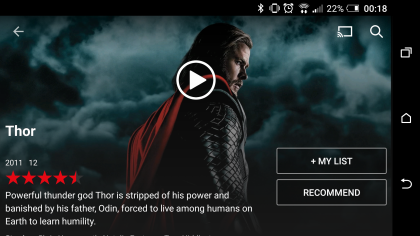
Make it so that I don't have to wriggle through the gallery to just get to the current series I'm watching - make it so that I can easily connect to Google Play Store from it and I can finish off the series I'm watching but don't have all the episodes for.
The issue here is that yeah, watching Netflix or your own content on the One A9 is a good experience visually, but the playback sucks. HTC needs to bite the bullet and develop its own amazing app - or at least cajole Google into making Play Movies as described above.
The screen is lovely and sharp for video though - as mentioned before the OLED technology is great for color reproduction and contrast ratio, so you'll get a decent experience.

Gareth has been part of the consumer technology world in a career spanning three decades. He started life as a staff writer on the fledgling TechRadar, and has grew with the site (primarily as phones, tablets and wearables editor) until becoming Global Editor in Chief in 2018. Gareth has written over 4,000 articles for TechRadar, has contributed expert insight to a number of other publications, chaired panels on zeitgeist technologies, presented at the Gadget Show Live as well as representing the brand on TV and radio for multiple channels including Sky, BBC, ITV and Al-Jazeera. Passionate about fitness, he can bore anyone rigid about stress management, sleep tracking, heart rate variance as well as bemoaning something about the latest iPhone, Galaxy or OLED TV.
